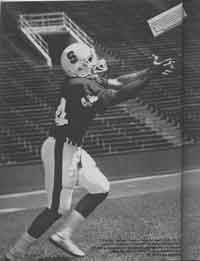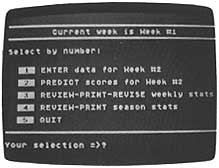

ANTIC VOL. 6, NO. 6 / OCTOBER 1987 / PAGE 36
 Beat the Las Vegas oddsmakers by picking the winning pro football point spreads with your Atari! Football Predictor had an impressive 59.6% season for 1986. This BASIC program works on Atari 8-bit computers with at least 32K memory and a disk drive.
Beat the Las Vegas oddsmakers by picking the winning pro football point spreads with your Atari! Football Predictor had an impressive 59.6% season for 1986. This BASIC program works on Atari 8-bit computers with at least 32K memory and a disk drive.
Is it really possible for your Atari to outguess the Las Vegas pro football oddsmakers? We think so, thanks to Football Predictor. For the National Football League's 1986 regular season, this Atari 8-bit program outguessed the official Las Vegas point spread 53 times versus 36 losses—a winning percentage of 59.6% against the spread.
According to scholars of gambling lore, any method that wins more than 58% is considered successful. In other words, if you managed your cash sensibly you could have made money betting with Football Predictor during the overall 1986 regular NFL season.
(Of course, the past successes of any prediction method don't guarantee future success. The authors and Antic Publishing disclaim all responsibility for whatever betting risks you may choose to take.—ANTIC ED)
Football Predictor's 59.6% success rate for 1986 is particularly impressive because it relies on a single statistical relationship and requires you to make minimal data entry for its predictions. Just enter each NFL game's net passing yardage, net rushing yardage, and points scored both for and against each team.
You can get these required statistics from the sports section of your local newspaper. Allow about 45 minutes each week for data entry.
Football Predictor covers all 28 current teams in the National Football League. But it could easily be modified to include any future expansion teams. Just change the variable T in line 110 to the new number of teams, then add the new team names to the DATA statements at the bottom of the listing.
Keep your working copy of the program on its own disk with only the DOS.SYS and DUP.SYS files for company. Leave the disk in drive 1 when you use it, because the program accesses the drive often. As the season progresses, 18 more files will be added to the disk.
 The following discussion of the main menu selections will lead you through the operations of Football Predictor.
The following discussion of the main menu selections will lead you through the operations of Football Predictor.
To finish your predictions, you'll need your sports pages' schedule of the following week's games and the Las Vegas spread. Press [OPTION] until a home team appears, then press [SELECT]. Do the same for the visitor. The program will quickly predict a winner and a point spread. If you make a mistake, start over by pressing [ESCAPE]. After entering at least one matchup, pressing [START] prints your predicted scores.
To predict each game's outcome relative to the Las Vegas line, compare the program's predictions with the point spread in the newspaper. If the Predictor favors one team above the published spread by at least 4 1/2 points, select that team to beat the spread.
For instance, if the line favors the 49ers over the Redskins by 2 points but the Predictor favors them by 6 1/2 points, pick the 49ers to beat the spread. Likewise, if the line favors the Redskins by 2 but the Predictor favors the 49ers by 2 1/2, go with the 49ers again. This 4 1/2 point "fudge factor" was used to obtain our 59.6% success rate.
Not every game played can be predicted against the spread. Only consider betting on games having a significant edge. One week in 1986, all 14 of the Predictor's predictions were less than 4 1/2 points away from the Las Vegas line.
No other factors are considered—not even home field advantage. So feel free to experiment: the program was written so as to be modified easily by any experienced BASIC programmer. If your modified version has a spectacularly successful 1987 season, send the modification to Antic to he considered for possible publication.
FOOTBALL GAMES
COMPUTER QUARTERBACK
Strategic Simulations, Inc.
1046 N. Rengstorff Avenue
Mountain View, CA 94043
(415) 964-1353
$39.95, Atari 8-bit, 48K disk
GFL CHAMPIONSHIP FOOTBALL
(Gamestar)
Activision Inc.
P.O. Box 7826
Mountain View, CA 94039
(415) 964-0410
$39.95, Atari ST
David Cowles and Bill Marquardt are computer professionals for the U.S. Postal Service in San Francisco. Dave originally wrote the Predictor on his IBM PC in 1984, and Bill converted it for the Atari and Apple II.
Listing 1 FPRED.BAS